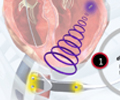Tag Archives: cardiovascular implantable electronic devices (CIEDs)

October 2018 Br J Cardiol 2018;25(suppl 3):S40–S43 doi:10.5837/bjc.2018.s19
Pacing supplement: Remote monitoring
John Morgan
| Full text
October 2018 Br J Cardiol 2018;25(suppl 3):S44–S45 doi:10.5837/bjc.2018.s20
Pacing supplement: Remote follow-up of implantable cardiac devices – a physiologist’s experience
Matthew Swift
| Full text

